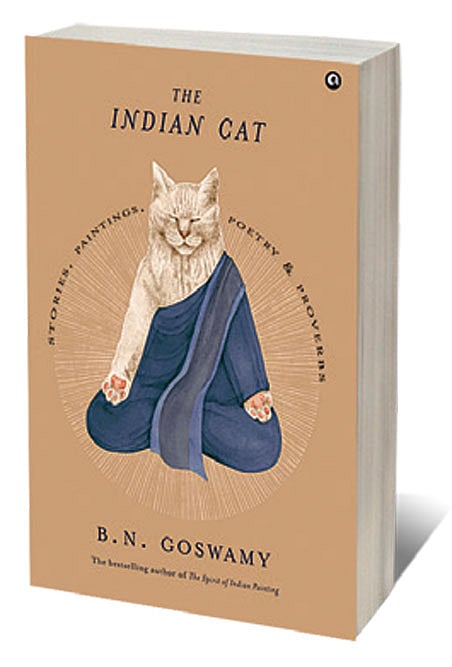Cat-alogue

BN GOSWAMY’S The Indian Cat opens with the most befitting first line for a book on the animal; “It is best to begin with a confession, I think. Strictly speaking, I am not a cat lover.” It is perhaps, because of this objective distance and disarming honesty that Goswamy’s compilation of stories, paintings, poetry and proverbs on cats is a masterclass in both whimsy and wisdom. He brings his immense knowledge (his books such as Essence of Indian Art, The Spirit of Indian Painting etc have moulded modern thinking on Indian art) to the feline and gives us a book that is both revelatory and playful. It makes no boastful claims, as it lays out at the very start; “This is simply a look—a bit quirky perhaps—at how the cat is viewed in India: how it was in the past, and how it is today.”
In the preface, Goswamy writes how a dear friend once admonished him that if he is an art historian, he ought to love cats. Though he wasn’t particularly convinced by this line of reasoning, he did realise that cats and cat metaphors did come up in Indian texts. For example, in the Mahabharata, Duryodhana accuses Yudhishthira of “marjara-vrata” (the literal translation is ‘a cat-like observance’ but it implies ‘concealing one’s malice or evil designs under the garb of piety or virtue’). These stray thoughts and the fact that his own son had adopted two cats got Goswamy thinking more deeply about them.
In India, if there are superstitions around cats, such as not crossing after a black one, there is also generosity, especially in the Buddhist and Islamic traditions. The Hadith includes stories about the Prophet’s love for cats. According to legend, writes Goswamy, the Prophet loved cats because once a snake crawled into his sleeve and refused to leave. A cat told the snake to show its head, and immediately pounced upon it. The Prophet was forever grateful to the cat for saving his life. He even had a pet cat named Muezza. Once when the Prophet returned from a mosque, Muezza bowed to him. Bemused and pleased, he stroked his cat three times. This gave all cats the ability to always land on their feet.
Perhaps the most compelling section of the book is ‘Cats in Paintings, Past & Present’, where Goswamy the art historian shines brightest. Through 58 carefully selected paintings, we get to see the cat in different settings and varied roles. Except for a handful, the cat is always subordinate to the human figures. At times, a viewer must squint into a painting to notice the cat at all, which might be half hidden by a woman’s knee or might be just a tiny figure standing outside a tent. Each painting is accompanied by just around 10 lines of text, and Goswamy’s insights make the viewer see the painting anew. In a tastefully ornate 18th-century painting, ‘Palace Ladies Celebrating Shab-e-Barat’ two palace cats (evident from their golden collars) enjoy a lavish meal. Goswamy interprets their smug expressions as the cat telling the viewer, “You know, of course, that dogs eat, cats dine.”
In these paintings the cat plays many roles, from sentry to companion to a royal vehicle. In the decadent ‘Lovers on a Terrace’, the cat warns, ‘no entry please, no disturbance’. In a 20th-century printed poster from Bengal, the cat is shown as the vahana of Shashthi, a folk goddess who is the protector of children. But cats appear most often as the companion of women. A snow-white cat sits by her princess in a late 18th-century painting from Deccan. In the Kalighat painting, ‘Courtesan with a Cat’, the pet is nearly the size of her mistress, and seems to be reassuring her that she is not alone.
The Indian Cat concludes with a selection of verses featuring cats, ranging from the Jatakas to the Mahabharata to Jibanananda Das to Vikram Seth. Goswamy has even translated a children’s game from Hindi, which reads, “What does a cat say? / Meow! Meow! Meow! Meow?! / No, she says / Main aaoon? Main aaoon? Main aaoon? Main aaoon? / May I come? May I come? May I come? May I come?” With The Indian Cat, Goswamy has ensured that the Indian cat hasn’t just come, it has truly arrived.

